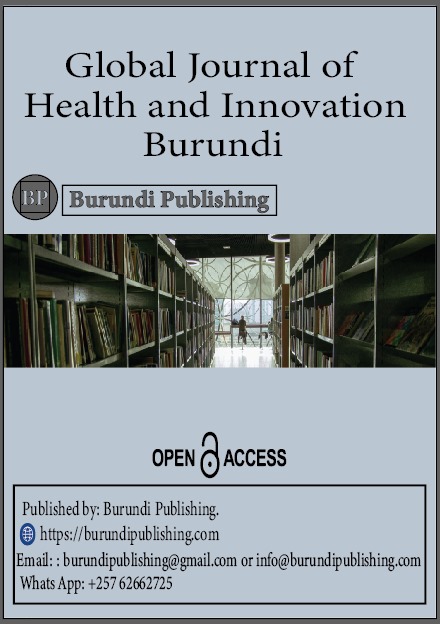PREVALENCE, KNOWLEDGE AND PRACTICES OF MALARIA PREVENTION AMONG PRIME GRAVIDAS IN LIRA CITY, NORTHERN UGANDA. A CROSS-SECTIONAL STUDY
DOI:
https://doi.org/10.70659/gjhib.v2i1.15Keywords:
Prevalence of malaria, Knowledge and practices of malaria prevention, Prime gravidas in Lira cityAbstract
Background
Malaria, caused by plasmodium parasites and transmitted by infected female mosquitoes, remains a significant public health issue, particularly in malaria-endemic regions. The study aims to establish the prevalence, knowledge, and practices of malaria prevention among prime gravidas in Lira City, Northern Uganda.
Methodology
A health facility-based cross-sectional study was conducted between April and May 2024, in Lira City. Data was collected among Prime Gravidas Aged 15-49 years using a structured questionnaire. Collected data was coded and entered into SPSS software version 23 and descriptively analyzed for frequencies and percentages.
Results
Most respondents, 249(59.4%) were in the age bracket (20-29) years, 163(38.9) of the respondents were self-employed, 252(60.1%) were married, Most 275(65.6%) tested positive for malaria and treated it in the past 1 year, 149(35.6%) of the respondents were hospitalized for malaria treatment in the past 1 year, Most 247(58.9%) suffered from malaria during pregnancy, 122(29.1%) suffered once from malaria during the pregnancy, majority 311(74.2%) had attended health education talk on malaria, 125(29.8%) of the respondents were very susceptible to malaria infection during their pregnancy, 96(22.9%) mentioned going late to bed/being exposed to the mosquito as a reason for their perceived susceptibility to malaria, most 379(90.5%) sought for treatment first after feeling for symptoms of malaria from Health workers.
Conclusion
There is a high prevalence of malaria among Prime gravidas. There was a significant association between knowledge, practices, and the prevalence of malaria among Prime Gravidas in Lira City, Northern Uganda.
Recommendation
Health education programs should be implemented to improve PG's knowledge of malaria, and further research should be done to explore the underlying factors influencing malaria prevention among Prime Gravidas.
References
Acio, H. S., Omech, B., & Oceng, F. A. (2022). Prevalence and Determinants of Asymptomatic Malaria Among Pregnant Women Attending Primary Health Care Services in Lira District/Lira City. Lira University.
Bujang, M. A., & Sa'at, N. (2016). Application of Consecutive Sampling Technique in a Clinical Survey for an Ordered Population: Does it Generate Accurate Statistics? THE PHILIPPINES, 87.
Dwumfour, C. K., Bam, V. B., Owusu, L. B., Poku, C. A., Kpabitey, R. D., Aboagye, P., & Ibrahim, A. S. (2023). Prevalence and determinants of malaria infection among pregnant women attending antenatal clinic in Ejisu government hospital in Ghana: A cross-sectional study. Plos one, 18(10), e0293420. https://doi.org/10.1371/journal.pone.0293420
Epuitai, J., Ndeezi, G., Nabirye, R. C., Kabiri, L., Mukunya, D., Tumuhamye, J., . . . Tumwine, J. K. (2023). Prevalence and factors associated with placental malaria in Lira District, Northern Uganda: a cross-sectional study. https://doi.org/10.21203/rs.3.rs-3258774/v1
Esomonu, S., Ossai, E., Gadzama, A., Ashikeni, M., & Uzochukwu, B. (2022). Knowledge and preventive practices against malaria among pregnant women in urban and rural public healthcare facilities in Nigeria's federal capital territory. International Journal of Medicine and Health Development, 27(1), 81-91. https://doi.org/10.4103/ijmh.IJMH_66_20
Jain, K., Gupta, P., Balodhi, A., Deeba, F., & Salam, N. (2022). Prevalence of Pregnancy Associated Malaria in India. Frontiers in Global Women's Health, 3, 832880-832880. https://doi.org/10.3389/fgwh.2022.832880
Mangusho, C., Mwebesa, E., Izudi, J., Aleni, M., Dricile, R., Ayiasi, R. M., & Legason, I. D. (2023). High prevalence of malaria in pregnancy among women attending antenatal care at a large referral hospital in northwestern Uganda: A cross-sectional study. Plos one, 18(4), e0283755. https://doi.org/10.1371/journal.pone.0283755
Mugoya, M. P. (2023). Prevalence and control of Malaria in Pregnant Antenatal Mothers at Main Hospital, Iganga District, Eastern Uganda. IDOSR Journal of Science and Technology, 9(1), 66. https://doi.org/10.59298/IDOSR/2023/01.1.1204
Musimenta, C., & Mubangizi, P. (2022). Knowledge, Attitude, and Practices Towards Prevention of Malaria among Pregnant Women aged 18-45 years at Busibo Health Centre III, Lwengo District. A Cross-section Study. Student's journal of health research Africa, 3(6). https://doi.org/10.51168/sjhrafrica.v2i6.171
Okafor, I. P., Ezekude, C., Oluwole, E. O., & Onigbogi, O. O. (2019). Malaria in pregnancy: A community-based study on the knowledge, perception, and prevention among Nigerian women. Journal of family medicine and primary care, 8(4), 1359-1364. https://doi.org/10.4103/jfmpc.jfmpc_295_18
Reddy, V., Weiss, D. J., Rozier, J., Ter Kuile, F. O., & Dellicour, S. (2023). Global estimates of the number of pregnancies at risk of malaria from 2007 to 2020: a demographic study. The Lancet Global Health, 11(1), e40-e47. https://doi.org/10.1016/S2214-109X(22)00431-4
Sileyew, K. J. (2019). Research design and methodology. Cyberspace, 1-12.
Tegegne, Y., Asmelash, D., Ambachew, S., Eshetie, S., Addisu, A., & Jejaw Zeleke, A. (2019). The Prevalence of Malaria among Pregnant Women in Ethiopia: A Systematic Review and Meta-Analysis. Journal of parasitology research, 2019, UBOS, S. (2022). Uganda Bureau of Statistics. Change, 2022.
https://doi.org/10.1155/2019/8396091
UN, U. N. (2015). TRANSFORMING OUR WORLD: THE 2030 AGENDA FOR SUSTAINABLE DEVELOPMENT
WHO, W. (2022). World Malaria Report 2022: World Health Organization.
Downloads
Published
How to Cite
Issue
Section
License
Copyright (c) 2025 Emmanuel Ojok Obura, Edward Kumakech

This work is licensed under a Creative Commons Attribution 4.0 International License.
License Information
All articles published in the Global Journal of Health and Innovation Burundi are licensed under the Creative Commons Attribution 4.0 International License (CC BY 4.0).
This license permits:
- Sharing: You can copy and redistribute the material in any medium or format.
- Adapting: You can remix, transform, and build upon the material for any purpose, including commercially.
Attribution Requirement: Users must provide appropriate credit to the original author(s), link to the license, and indicate if changes were made.






